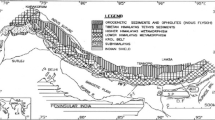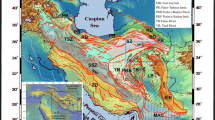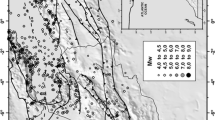Abstract
We examined seismic characteristics, b value and fractal dimension of the aftershock sequence of the January 26, 2001 Bhuj earthquake (Mw 7.7) that occurred in the Kutch failed rift basin, western margin of the Stable Continental Region (SCR) of India. A total of about 2,000 events (M ≥ 2.0) were recorded within two and a half months, immediately after the main shock. Some 795 events were precisely relocated by simultaneous inversion. These relocated events are used for mapping the frequency-magnitude relation (b value) and fractal correlation dimension (Dc) to understand the seismic characteristics of the aftershocks and the source zone of the main shock. The surface maps of the b value and Dc reveal two distinct tectonic arms or zones of the V-shaped aftershock area, western zone and eastern zone. The b value is relatively higher (~1.6) in the western zone compared to a lower value (~1.4) in the eastern zone. The Dc map also shows a higher value (1.2–1.35) in the western zone compared to a lower Dc (0.80–1.15) in the eastern zone; this implies a positive correlation between Dc and b value. Two cross sections, E–W and N–S, are examined. The E–W sections show similar characteristics, higher b value and higher Dc in the western zone and lower in the eastern zone with depth. The N–S sections across the fault zones, however, show unique features; it imaged both the b and Dc characteristics convincingly to identify two known faults, the Kutch Mainland fault and the South Wagad fault (SWF), one stepping over the other with a seismogenic source zone at depth (20–35 km). The source zone at depth is imaged with a relatively lower b and higher Dc at the ‘fault end’ of the SWF showing a negative correlation. These observations, corroborated with the seismic tomography as well as with the proposed geological/tectonic model, shed a new light to our understanding on seismogenesis of the largest SCR earthquake in India in the recent years.








Similar content being viewed by others
References
Aki, K. (1965), Maximum-likelihood estimate of b in the formula of log N = a − bM and its confidence limits, Bull Earthquake Res Inst, University of Tokyo, 43, 237–239.
Ambraseys, N. N. and Doglas, J. (2004), Magnitude calibration of north Indian earthquakes, Geophys J Int, 159, 165–206.
Bhattacharya, P. M., Majumdar, R. K. and Kayal, J. R. (2002), Fractal dimension and b-value mapping in northeast India, Curr Sci, 82(12), 1486–1491.
Bis (2004), Seismic Zoning Map of India, Bureau Indian Standard (BIS) publication, New Delhi, India.
Biswas, S.K. (1987), Regional tectonic framework, structure and evolution of the western marginal basins of India, Tectonophysics, 135, 307–327.
Biswas, S. K. (2005), A review of structure and tectonics of Kutch basin, western India with special reference to earthquakes, Curr Sci, 88(10), 1592–1600.
Biswas, S K. (2011), Structure, tectonics and active faults of Kutch rift basin, Gujarat, Western India, International Symposium: The 2001 Bhuj Earthquake and Advances in Earthquake Sciences, Inst Seism Res, Gandhinagar, India, January 22–24, Abstract Volume, pp 128–129.
Bodin, P. and Horton, S. (2004), Source parameters and tectonic implications of aftershocks of the Mw 7.6 Bhuj earthquake of 26 January 2001, Bull Seism Soc Am, 94, 818–827.
Chandrasekhar, D. V., Singh, B., Firozishah, Md., and Mishra, D.C. (2005), Analysis of Gravity and Magnetic anomalies of Kachchh rift basin, India and its comparison with New Madrid seismic zone, USA, Curr Sci, 88(10), 1601–1608.
Chen, C. C., Wang, W.C., Chang, Y. F., Wu, Y.M., LEE, Y H., 2006. A correlation between the b-value and the fractal dimension from the aftershock sequence of the 1999 Chi–Chi, Taiwan, earthquake, Geophys J Int, 167, 1215–1219. doi:10.1111/j.1365-246X.2006.03230.x.
Chung, W. and Gao, H. (1995), Source parameters of the Anjar earthquake of July 21, 1956, India, and its seismotectonic implications for the Kutch rift basin, Tectonophysics, 242, 281–292.
Dimri, V.P., Vedanti, N., and Chattopadhyay, S. (2005), Fractal analysis of the aftershock sequence of the Bhuj earthquake: A wavelet based approach, Curr Sci, 88(10), 1617–1620.
Ellis, M., Gomber, J. and Schweig, E. (2001), Indian earthquake may serve as analog for New Madrid earthquakes, Eos Trans. AGU, 82(32), 345, doi:10.1029/01EO00211.
Grassberger, P. and Procaccia, I. (1983), Measuring the strangeness of strange attractors. Physica, 9, 189–208.
Gutenberg, B. and Richter, C. F. (1944), Frequency of earthquakes in California, Bull Seism Soc Am, 34, 185–188.
Hirata, T. (1989), A correlation between the b value and the fractal dimension of earthquakes, J Geophys Res, 94, 7507–7514.
Idziak, A. and Teper, L. (1996), Fractal dimension of faults network in the upper Silesian coal basin Poland: Preliminary studies, Pure Appl Geophys, 147, 239–247.
Kagan, Y.Y. and Knopoff, L. (1980), Spatial distribution of earthquakes: The two point correlation function, Geophys J R Astro Soc, 62, 303–320.
Kayal, J. R. (2008), Microearthquake Seismology and Seismotectonics of South Asia, Springer, Germany and Capital Pub, New Delhi, India, 505p.
Kayal, J. R., De R., Sagina Ram, Srirama, B.V., Gaonkar, S. G. (2002a), Aftershocks of the 26 January, 2001 Bhuj earthquake in western India and its seismotectonic implications, J Geol Soc India, 59, 395–417.
Kayal, J. R., Zhao, D., Mishra, O. P., De, R. and Singh O. P. (2002b), The 2001 Bhuj earthquake: Tomography evidence for fluids at hypocenter and its implications for rupture nucleation, Geophys Res Lett, 29(24), 51–54.
Kayal, J. R. and Mukhopadhyay, S. (2006), Seismotectonics of the 2001 Bhuj earthquake (Mw 7.7) in western India: Constraints from aftershocks, J Indian Geophys Union, 10(1), 45–57.
Main, I. G. (1991), Damage mechanism with long range interactions: Correlation between the seismic b-value and the fractal two point correlation dimension, Geophys J Int, 107, 531–541.
Mandal, P., Rastogi, B. K., Satyanarayana, H. V. S., Kousalya, M., Vijayraghavan, R., Satyamurthy, C., Raju, I. P., Sarma, A. N. S. and Kumar, N. (2004), Characterization of the causative fault system for the 2001 Bhuj aftershocks, Tectonophysics, 378, 105–121.
Mandal, P. and Rastogi, B. K. (2005), Self-organized fractal seismicity and b-value of aftershocks of the 2001 Bhuj earthquake in Kutch (India), Pure Appl Geophys, 162, 53–72.
Mandal, P. and Pujol, J. (2006), Seismic imaging of the Aftershock zone of the 2001 Mw7.7 Bhuj earthquake, India, Geophys Res Lett, 33, 1–4, L05309.
Mishra, O. P. and Zhao, D. (2003), Crack density saturation rate and porosity at the 2001 Bhuj, India earthquake hypocenter: A fluid driven earthquake, Earth Planet Sci Lett, 212, 393–405.
Mogi, K. (1962), Magnitude-frequency relation for elastic shocks accompanying fractures of various materials and some related problems in earthquakes. Bull Earthquake Res Inst, University of Tokyo 40, 831–853.
Nanjo, K., Nagahama, H. and Satmura, M. (1998), Roles of aftershock decay and the fractal structure of active fault systems, Tectonophysics, 287, 173–18.
Negishi, H., Mori, J., Sato, T., Singh, R., Kumar, S. and Hirata, N. (2002), Size and orientation of the fault plane for the 2001 Gujarat, India earthquake Mw 7.7 from aftershock observations: A high stress drop event, Geophy Res Lett, 29 (20), 10-1–10-4.
Oldham, R. D. (1926), The Cutch earthquake of 16 June 1819 with a revision of the great earthquake of 12 June 1897, Mem Geol Surv. India, 46, 1–77.
Ouchi, T. and Uekawa, T. (1986), Statistical analysis of the spatial distribution of earthquakes—variation of the spatial distribution of earthquakes before and after large earthquakes, Phys Earth and Planet Inter, 44, 211–225.
Pande, P. and Kayal, J. R. (2003), Kutch (Bhuj) Earthquake, 26 January, 2001, Geol Surv India, Sp Pub, 76, 282p.
Pande, P., Kayal, J. R., Joshi, Y. C. and Ghevaria, Z. G. (2003), Lithospheric framework of Gujarat and adjoining regions, In: Kutch (Bhuj) Earthquake, 26 January, 2001, Geol Surv India, Sp Pub, Ed. Pande, P and Kayal, J R., 76, 5–9.
Roy, S., Ghosh, U., Hazra, S, and Kayal, J R. (2010), Fractal dimension and b-value mapping in the Andaman-Sumatra subduction zone, Nat Haz, doi:10.1007/s11069-010-9667-6.
Shi, Y. and Bolt, B. (1982), The standard error of magnitude-frequency b value, Bull Seism Soc Am, 72, 1677–1687.
Smith, W. D. (1981), The b-value as an earthquake precursor, Nature, 289, 136–139.
Sunmonu, A. and Dimri, V. P. (1999), Fractal analysis and seismicity of Bengal basin and Tripura fold belt, northeast India, J. Geol Soc India, 53, 587–592.
Talwani, P. and Gangopadhyay, A. (2001), Tectonic framework of the Kachchh earthquake of January 26, 2001, Seism Res Lett, 72, 336–345.
Tosi, P. (1998), Seismogenic structure behavior revealed by spatial clustering of seismicity in the Umbria-Marche region, (Central Italy), Annali Di Geofisica, 41(2), 215–224.
Urbancic, T. I., Trifu, C. I., Long, J. M. and Young, R. P. (1992), Space-time correlations of b values with stress release, Pure Appl Geophys, 139, 449–462.
Weimer, S. and Wyss, M. (1997), Mapping the frequency distribution in asperities: An improved technique to calculate recurrence times, J Geophys Res, 102(15), 115–128.
Acknowledgments
We sincerely thank the editor and the reviewers for their constructive suggestions and comments to improve the manuscript to its present form. In the event of successful completion of the work, one of the authors, VD would like to thank the head, Department of Applied Geophysics, Indian School of Mines, Dhanbad for allowing him to undertake the project as part of his summer research work at the School of Oceanographic Studies, Jadavpur University, Kolkata, India. Ms Sohini Roy, Jadavpur University is gratefully acknowledged for her help and cooperation in some of the computational work.
Author information
Authors and Affiliations
Corresponding author
Rights and permissions
About this article
Cite this article
Kayal, J.R., Das, V. & Ghosh, U. An Appraisal of the 2001 Bhuj Earthquake (Mw 7.7, India) Source Zone: Fractal Dimension and b Value Mapping of the Aftershock Sequence. Pure Appl. Geophys. 169, 2127–2138 (2012). https://doi.org/10.1007/s00024-012-0503-7
Received:
Accepted:
Published:
Issue Date:
DOI: https://doi.org/10.1007/s00024-012-0503-7




